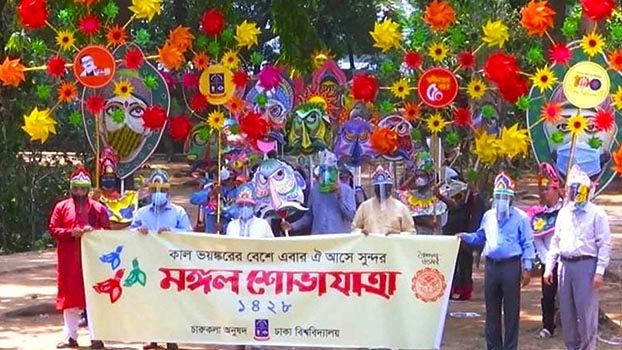Symbolic Mangal Shobhajatra hails 1428


Mangal Shobhajatra has become a tradition to welcome the Bangla New Year in Bangladesh. It is considered as an expression of the secular identity of the Bangladeshi people and as a way to promote unity. The UNESCO also declared it as an ‘intangible cultural heritage’ in 2016.
But the Covid-19 pandemic has compelled the authorities to stop all sorts of mass gatherings.
To keep the tradition, however, Dhaka University authority became innovative. They brought out a token procession inside the campus without the participations of mass people on Wednesday to welcome Pahela Boishak, the first day of the year.
Wearing masks and maintaining physical distancing, State Minister for Cultural Affairs KM Khalid, DU Vice-Chancellor Prof Md Akhtaruzzaman led the procession.
Pro-VC Prof ASM Maksud Kamal, Treasurer Prof Momtaz Uddin Ahmed, Dean of faculty of the Fine Arts Prof Nisar Ahmed, DU Teachers’ Association President Prof M Rahmat Ullah, and General Secretary Prof Nizamul Haque Bhuiyan and few other teachers and students of Fine Arts Faculty joined them.
They also carried symbols made by the students of faculty of the fine arts.
Mangal Shobhajatra is a mass procession that takes place at dawn on the Pahela Boishak since 1989. The UN cultural and education agency, UNESCO, declared it as an ‘intangible cultural heritage’ in 2016 inscribing this on the ‘Representative List of the Intangible Cultural Heritage of Humanity’.
“The Mangal Shobhajatra festival symbolizes the pride the people of Bangladesh have in their folk heritage, as well as their strength and courage to fight against sinister forces, and their vindication of truth and justice. It also represents solidarity and a shared value for democracy, uniting people irrespective of caste, creed, religion, gender or age. Knowledge and skills are transmitted by students and teachers within the community,” the UNESCO said.
Members of the university faculty work together a month before the festival to create masks, symbols to drive away evil forces and allow for progress, and floats.
Among works made for the festival at least one will represent evil, another courage and strength and a third, peace. Items to sell on the day are also produced as a source of funding, such as paintings on Bangladesh folk heritage.

